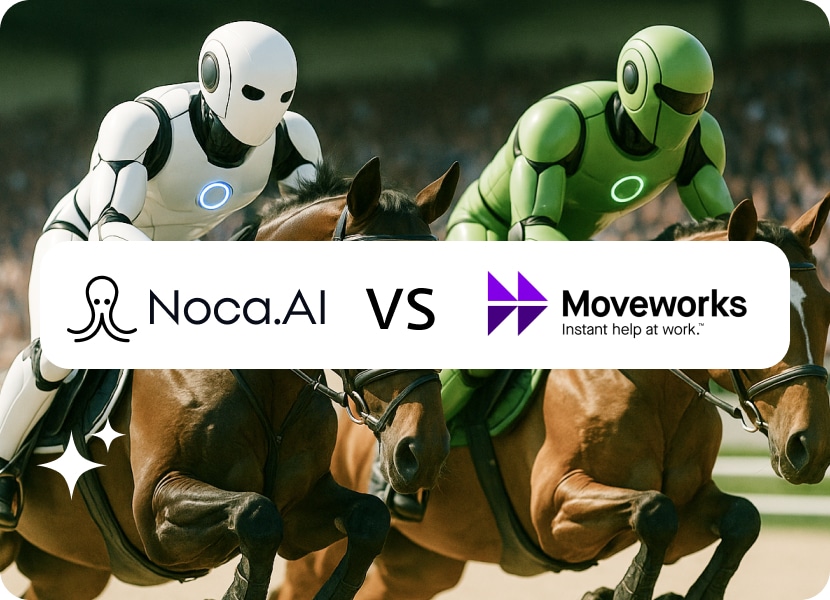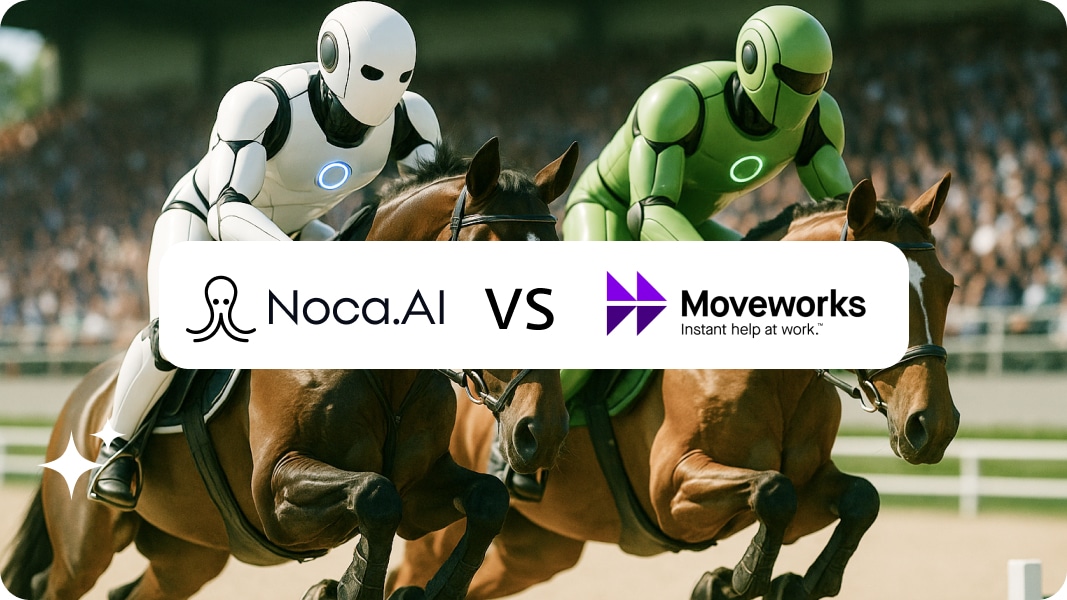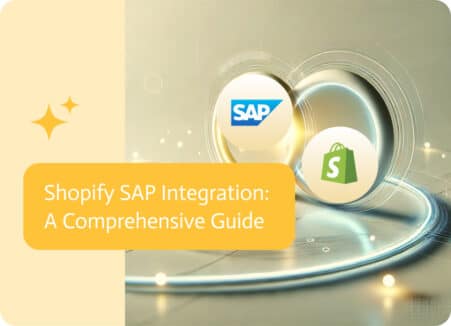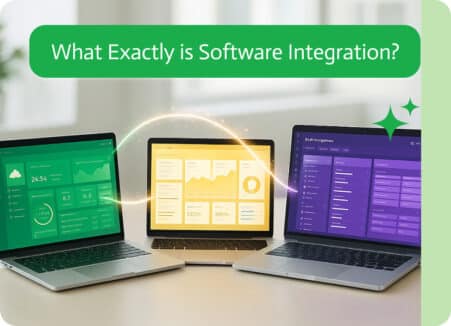

Noca vs. Moveworks: Digital Employee Builders
So ServiceNow just dropped $2.85 billion to acquire Moveworks in March 2025. That’s billion with a B. The deal’s still pending regulatory approval, but this tells you everything about where enterprise AI is heading. Big companies are doubling down, investing huge amounts in digital employees, and they’re scrambling to own the platforms that build them. This is why we’ve had to do a Noca vs. Motionworks comparison, to give you a better idea of who offers what and which one deserves your consideration.
One is purpose-built for businesses that want customizable AI agents platform integrated with all the systems they’re using, and the other is a massive enterprise platform that just became part of an even more massive enterprise ecosystem. So, without further delay, let’s see who earns a spot on your virtual payroll.
What’s Really At Stake Here?
Digital employees aren’t just fancy chatbots with delusions of grandeur. They’re AI-powered workers that handle complete business processes from start to finish. Think of them as hiring virtual teams that can navigate your architecture, make split-second decisions according to your business rules, and complete multi-step workflows.
The difference between a good platform and a mediocre one isn’t just the features on offer, it’s whether or not your digital employees actually integrate with the ways in which your business works today or whether they force you to rebuild everything around their vision of how you should operate.
Meet The Contenders: Noca vs. Moveworks
Noca: Built For Business Flexibility
Noca is letting any business build bespoke digital employees that work exactly how they need them to work. No enterprise bloat, no forcing you into someone else’s ecosystem, just straightforward AI workforce creation that integrates with your current tools.
Noca uses language to build digital employees, meaning you describe what you need in plain English, and Noca constructs the digital employee to match. Want a digital employee handling finance data analysis across three different systems and giving you insights to your sales team? Describe the workflow, connect the systems, and deploy. It’s the practical approach to AI agent worker, with a focus on actual problems instead of sales pitches.
Noca is all about focus. This isn’t a platform trying to be your IT service desk, your knowledge base, and your digital assistant all at once. It’s a digital employee builder, period. Build them, deploy them, manage them, and test. That means everything the platform does is designed to make your digital employee more capable and easier to manage.
Moveworks: The Enterprise Giant (Now Part of ServiceNow)
Moveworks burst onto the enterprise scene in 2019 with AI-powered IT support automation. They’ve since become a full-blown employee support platform used by over 5 million employees across 350+ enterprises, including household names like Toyota, Unilever, and Palo Alto Networks.
Their AI-assisted helper handles everything from IT ticket resolution to HR queries to knowledge search across enterprise applications. They’ve got 100+ pre-built agents via their Agent Marketplace, covering IT, HR, finance, and more. Their Agent Studio lets developers build custom automation, though “lets” might be generous.
Moveworks was valued at $2.1 billion in 2021, hit $100 million in annual revenue by September 2024, and then got acquired by ServiceNow for $2.85 billion in March 2025. That acquisition completely changes what Moveworks is. It’s no longer an independent AI assistant platform, it’s becoming part of ServiceNow’s massive workflow automation ecosystem.
What does that mean for you? If you’re already deep in the ServiceNow ecosystem, well, it then could be a great integration. If you’re not? You’re potentially buying into a platform that’s being fundamentally reshaped to serve ServiceNow’s strategic vision, not necessarily yours.
Noca vs. Moveworks: The Setup Reality Check
Noca: Fast and Focused
Getting started with Noca is refreshingly direct. You sign up, describe your first digital employee in natural language, connect it to your business systems, and start testing. Most businesses have functional digital employees running within hours, not weeks or months.
This speed will prove to be a major drawcard, as every day spent in “implementation” is another day your team is doing manual work that should be automated. Noca gets you from “we need this automated” to “it’s now automated” faster than enterprise platforms get you through their discovery call process.
Moveworks: Enterprise Onboarding Theater
Moveworks’ setup follows the classic enterprise software playbook, which is code for long and complicated. You’re not just configuring a digital employee, you’re linking it to your knowledge bases, setting up security, authentication, user permissions, and going through training.
Implementation typically takes weeks or even months, it all depends on your organization’s complexity. You’ll work with Moveworks’ professional services team (read: additional costs) and possibly certified partners (more costs) to get everything configured properly.
Reports suggest Moveworks typically costs between $100 and $200 per user per year, with total costs often reaching six figures annually for midsize to large organizations. Multi-year contracts are common, and onboarding can take up to several weeks to months.
If you’re a sizable company with a surplus of IT gurus and time to spare, this might be fine. But if you’re a regular business trying to use AI workers without a massive backing, it’s annoying. Plus, now that ServiceNow owns them, there’s no telling how setup might change.
Noca vs. Moveworks: Building Your Digital Workforce
Noca: Customization Without Complications
Noca lets you build tailored digital employees according to your processes. You describe what the digital worker should do, define the business structure and focal points, connect it to your systems, and deploy.
Noca handles the complex AI architecture while presenting you with straightforward options. Need to modify behavior based on real-world performance? All you’ll need to do is update the instructions conversationally.
Adaptability ensures your digital employees can handle unique workflows that don’t fit pre-built templates. You’re not trying to force your business processes into someone else’s idea of how things should work. You’re building AI workers that execute your processes exactly as designed.
Noca’s architecture is all about integration, so your digital employees work across your tech stack, whether that’s Salesforce, HubSpot, custom databases, or industry-specific software. The AI workers go where your business lives, not the other way around.
Moveworks: Pre-Built Power with Platform Lock-In
Moveworks offers over 100 pre-built agents for IT, HR, finance, and more through the Agent Marketplace, with deep integrations for common applications like ServiceNow, SAP, Workday, and Salesforce. Thanks to this, pre-built digital employees can be quickly deployed if your needs match their capabilities.
Their Agent Studio provides a low-code developer platform for building and automating complex multi-step business processes. However, “low-code” in enterprise speak all too often stands for “less code than building from scratch, but still requires technical prowess of our specific framework.”
The biggest issue is platform dependency. Moveworks’ power comes from its integration with enterprise systems, particularly ServiceNow. Your digital employees live inside the Moveworks ecosystem, which works brilliantly if that ecosystem matches your needs, but creates friction when it doesn’t.
And now with the ServiceNow acquisition? Everything is in flux. The product roadmap looks like it’s going to prioritize ServiceNow customers more and more. If you’re not in that world, you’re betting on a platform being rebuilt for someone else’s priorities.
Noca vs. Moveworks Integration: Where it Counts
Noca: Works With What You Have
Noca believes your digital employees are meant to easily connect with the systems that you’re already utilizing, and not replace them. Noca’s robust APIs, webhooks, and pre-built connectors are offered for major business tools.
This integration-first approach means you can deploy digital employees without fear of causing any unwanted disruptions to your processes. Your team keeps using the tools they know, and the digital employees slot into workflows rather than forcing you to adopt something completely new. It’s the pragmatic approach: enhance what works rather than replace everything.
Moveworks: The ServiceNow Universe
Moveworks provides powerful enterprise search that certainly assists with locating information all throughout business systems, aggregating info across knowledge bases, articles, documents, and more. That search capability is impressive, but it’s clear to see that it works best within ServiceNow’s ecosystem.
The ServiceNow acquisition is explicitly about combining ServiceNow’s workflow automation strengths with Moveworks’ digital employee and enterprise searching features. Its aimed at a smooth experience from request to resolution, with ServiceNow’s platform setting up the back-end workflow automation and Moveworks providing the front-end assistant.
Analysts have noted that this acquisition leaves gaps in hyperautomation, industry-specific AI solutions and begs the question of whether Moveworks’ unstructured approach will integrate with ServiceNow’s model. These aren’t trivial concerns, they’re fundamental architectural questions that will take years to fully resolve.
The Pricing Conversation of Noca vs. Moveworks
Noca: Transparency
Noca offers straightforward pricing based on what you’re actually getting: digital employee capabilities. The tiers scale as your needs grow, from small businesses deploying a few AI workers to enterprises running entire digital workforces. Starting with free all the way to custom, with large-scale businesses being able to opt for a $150 growth scheme.
Moveworks: Enterprise Pricing Plus Acquisition Uncertainty
Pricing insights suggest Moveworks typically costs between $100 and $200 per user per year, with total costs reaching six figures annually for midsize to large organizations. But that’s just the platform.
Then you have setup fees, service fees, training costs, and support fees. ServiceNow expects to incur integration costs ranging from $150 million to $300 million over the next 12 months following the acquisition. While those are ServiceNow’s costs, they signal just how complicated the merging of these platforms will be.
For existing Moveworks customers, pricing stability during the acquisition transition is uncertain. For new customers, you’re betting on pricing that could change significantly as the platform merges with ServiceNow’s commercial structure. Enterprise software acquisitions rarely make things cheaper or simpler for customers.
Real-World Usage: Noca vs. Moveworks
Working With Noca
Noca’s daily experience centers on your digital employees doing all the monotonous work. You monitor their performance through clear dashboards, adjust workflows as you need, and scale your digital workforce as new automation opportunities present themselves.
When something needs adjustment, you state the change conversationally. The platform translates your instructions into modified AI behavior, so there’s no need for you to understand technical architecture. It’s workforce management, not platform administration.
Working With Moveworks
Moveworks serves 350+ large enterprises, currently over 5 million employees, including 10% of the Fortune 500, with customers like Hearst, Instacart, Palo Alto Networks, Siemens, Toyota, and Unilever.
Users interact with Moveworks through conversations across channels and ServiceNow. The digital employee answers questions, automates, and resolves support requests. For common enterprise use cases like IT support, resets, and knowledge search, Moveworks handles these effectively.
But the platform can be complicated in less common situations. Custom workflows require tech skills to build and keep running. Real deployment involves coordinating security, compliance, and your current processes, which becomes quite difficult with legacy systems, not to mention there’s always the risk that misconfigured digital employees cause problems across critical systems.
The Enterprise Complexity Problem
Noca: Complexity Where It Belongs
Noca handles the complexity of architecture so you don’t have to. Your job is defining what your digital employees should do and how they should do it. Noca’s job is making that happen reliably. This division of responsibility means you’re not trying to become an expert, you’re using artificial intelligence to tackle business problems.
Noca scales complexity appropriately. Simple automation stays simple, and sophisticated workflows get the capabilities they need. You’re not paying for enterprise-grade everything when you need straightforward automation, but you’re not limited when you need advanced skills.
Moveworks: Enterprise Complexity On Display
Moveworks is a horizontal AI platform lacking industry-specific models for highly regulated sectors, and ServiceNow’s structured model may conflict with Moveworks’ strength in unstructured analysis. These shouldn’t just be considered as technical details, because they’re real drawbacks of how the platform works.
The enterprise focus means Moveworks assumes you have resources. Implementation teams, IT staff who know your systems and theirs, and security teams to configure policies and manage every aspect constantly. That assumption works for Fortune 500 companies with dedicated teams. It’s problematic for everyone else.
Noca vs. Moveworks: The Honest Verdict
Moveworks built an impressive enterprise digital employee platform that attracted major customers and a $2.85 billion acquisition. That’s a remarkable achievement and does somewhat convey the real value.
But getting acquired by ServiceNow fundamentally changes what Moveworks is. It’s no longer an independent platform making its own strategic decisions. It’s being merged into a much larger ecosystem that does have slightly different priorities, different customers, and a different vision.
Noca represents a completely different approach: purpose-built for digital employee creation, platform-agnostic integration, transparent pricing, and rapid deployment — all powered by vibe coding. No acquisition drama, no ecosystem lock-in, no multi-month implementations. Just focused capability for building, deploying, and, of course, managing digital employees that solve real business problems.
The choice seems obvious, but hey, maybe you enjoy living dangerously. Just remember: your competitors aren’t waiting for ServiceNow to finish integrating Moveworks. They’re deploying digital employees that work today, not platforms that claim to work better eventually after the acquisition dust settles.


